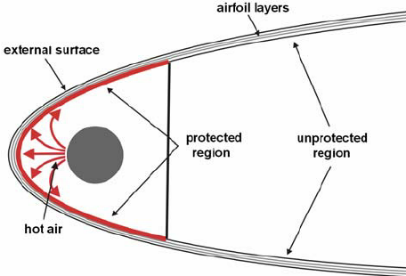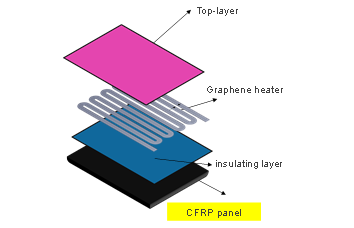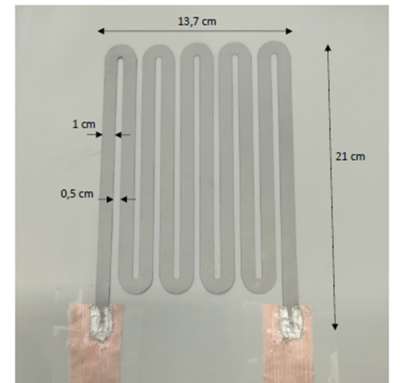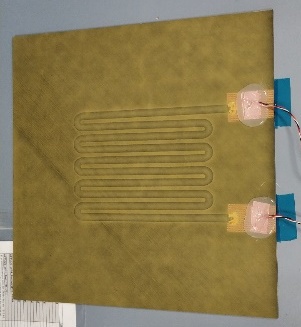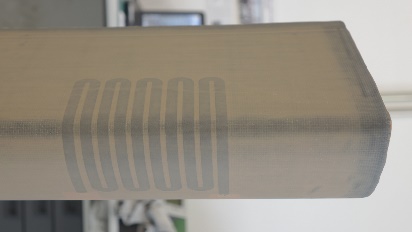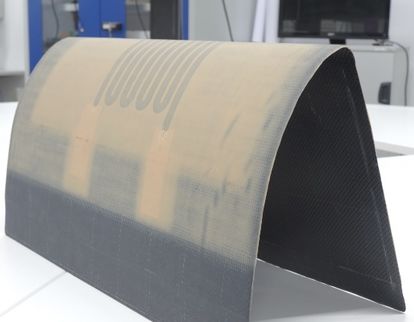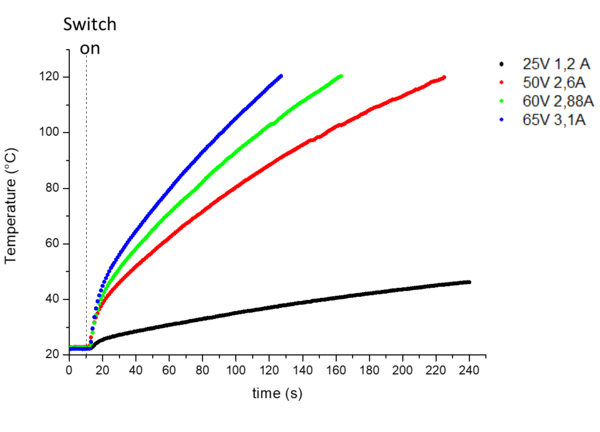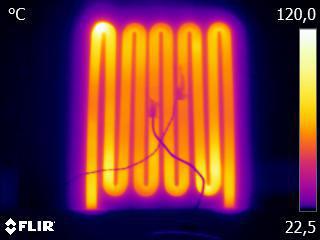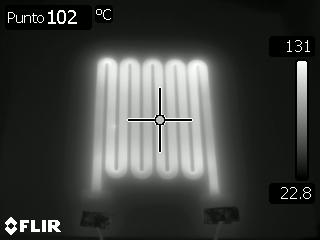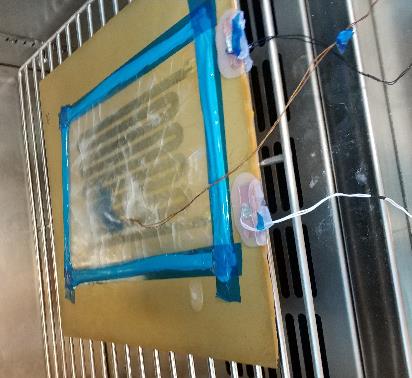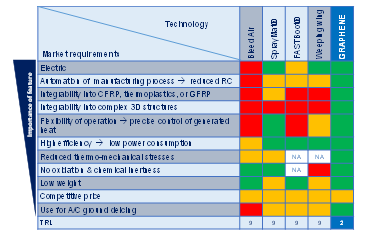1 Introduction
Commercial aircrafts need implementation of anti-icing (ice prevention) and de-icing (ice elimination or mitigation) systems in order to avoid detrimental effect in aerodynamic profiles and any linked safety concern. Current solutions are mainly bleed based, that is piccolo tubes, which consist of titanium pipes inserted into the wing slat. They distribute the hot air from the engine to the leading edge to avoid the accumulation of ice on the wing surface, see Figure 1. However, they have some disadvantages like incompatibility with composite parts, due to high temperatures that composite resins cannot stand, as well as low efficiency in terms of heating. Additionally, current aeronautical trend going in the direction of more electrical aircraft, which directly involves bleed-less systems, requires inherently more electro-thermal ice protection systems (IPS) providing enough heat flux, which are already paving its way into commercial aircraft.
In current aircrafts, there are key areas including IPS: wing leading edge, engine inlets, nacelle lips, pylon structures. However, there are other areas, which although do not have IPS currently, may benefit highly from it in terms of size and weight saving, e.g. Horizontal or Vertical Tail Plane (HTP or VTP).
Graphene is a nanomaterial, an allotrope of carbon whose structure is a one-atom thick planar sheet of carbon atoms bonded in a honeycomb crystal lattice. It is usually defined as the most promising ever-discovered material due to its unique electronic / electrical, mechanical, thermal, optical and chemical properties, which is expected to change our world and society. Electrical and thermal conductivity of graphene, as well as its low density, compatibility with carbon fiber reinforced polymers (CFRP) and multi-functionality, makes it a very interesting material for the realization of electro-thermal system for the anti- or de-icing function in aircrafts [1]. This system uses resistive circuits to generate heat when an electrical current is applied by Joule effect, which correlates the heat generated and the dissipation of kinetic energy of electrons flowing through a conductor material. Then, assuming the element behaves as a perfect resistor and that the applied power P is completely converted into heat (PElectrical= PThermal), P can be expressed by:
|
|
(1) |
|
|
(2) |
Where I is the electrical current flowing through the heating circuit and R its resistance. This resistance depends on material resistivity (ρ) and circuit geometry: length (l) and surface area (A).
2 Manufacturing status
2.1 Multilayer approach
The project was focused on exploiting the 2D nature of graphene related materials, as well as on developing an industrial solution to be fully compatible with current industrial manufacturing processes used to produce aeronautical parts made of carbon fiber reinforced epoxy resin (Automatic Tape Laying - ATL or Automatic Fiber Placement- AFP, autoclave curing…), as well as with external anti-erosion protection metallic sheet in case needed. Thus, among the different forms of graphene, it was chosen to use a foil produced with graphene nanoplatelets preassembled in sheets or rolls. This foil, called graphene paper, shows high electrical and thermal conductivity, good bendability and processability, further, it is chemically and thermally stable [2, 3]. The integration of graphene paper within CFRP was performed by a multi-layer system for anti- / de-icing purpose [4, 5], as indicated in Figure 2 and Table 1.
| Layer | Requirements | Selection |
| Top layer |
* Protection of heater against damage * T resistance ≥ epoxy Maxium Operation Limit (MOL) * Easy to integrate in CFRP * Qualified for airframe |
Epoxy adhesive film |
| Heater |
* Electrical properties for specific high heat output * Low density * Easy to manufacture and integrate in CFRP * Chemically and thermally stable * Flexible |
Graphene circuit |
| Insulating layer |
* Thermal and electrical insulation against CFRP material * T resistance ≥ epoxy MOL * Easy to integrate in CFRP |
Epoxy adhesive film or Glass Fiber Reinforced Polymer (GFRP) |
| Connectors |
* Mechanically stable * Good behavior against corrosion (chemical stable) |
Copper grid bonded with silver paste |
2.2 Graphene serpentine
The serpentines are prepared from graphene sheets or papers supplied by Nanesa, with dimensions of 210 mm x 300 mm x 50 microns, and a sheet resistance (Rs) of about 0,1 ohm/sq. The graphene paper is patterned by using an automatic cutting machine to obtain final shape [3]. The selected graphene design for this project is a serpentine, in order to optimize power consumption, see Figure 3. The typical resistance of the circuit is 20-30 ohm. Ending connections of this circuit are bonded by silver paint and conductive epoxy to ribbons of copper grid, to which cables will be attached to introduce the electrical current.
2.3 Produced panels
Following the multilayer approach defined, several panels were produced to demonstrate the concept feasibility, as well as to obtain panels for heating and de- icing performance evaluation.
In case of flat panels, see Figure 4, the following two manufacturing processes were followed:
* Bonding of graphene serpentine
- The graphene-based serpentine is deposited on a cured CFRP panel, including insulating layer (GFRP or adhesive layer), produced by manual lay-up and autoclave curing.
- The serpentine is covered with an epoxy adhesive layer.
- Epoxy adhesive is cured in an hot press at 177°C for 90 minutes at 3,4 bar (pressure on the sample).
* Co-curing of graphene serpentine
- Manual lay-up: CFRP layers, insulation layer, graphene serpentine and top layer
- Curing in autoclave: standard curing cycle for epoxy prepreg: 180ºC, 2 hours, 7 bar pressure, vacuum bag.
To test the bendability and capability of the heating graphene circuit to adapt to final shape, a manufacturing trial was performed. The graphene serpentine was co-cured in an oven with CFRP and insulation layers on a curved mold, which is representative of a Single Aisle HTP leading edge shape, obtaining good integration quality result, without visual defects, as it can be seen in Figure 5.
3 Performance status
3.1 Requirements
In order to perform a performance evaluation of the graphene based concept defined, first step was to define clear requirements for the solution proposed.
* Functionality / de-/anti-icing requirements:
- Specific heat power or heat flux: 20 kW/m2 – 50 kW/m2.
- Total power (on aircraft level): ~ 150 – 160 kW (Anti-icing, fully evaporative).
- Surface temperature, in icing conditions:
- Anti-icing: for fully evaporative anti-icing 40°C
- De-icing: for a non-evaporative system surface temperature above 0°C
- Voltage: 230V AC, 3-phase, or 540V DC (+/-270V), in case of more electrical aircraft.
- Homogeneous heating, no high temperature difference in heated area.
* Operability requirements:
- Compatible with CFRP substrates (epoxy resin), with Maximum Operation Limit, MOL ≤ 100ºC (maximum temperature in continuous operation).
- Resistance to operating fluids (water, hydraulic fluid, de-icing fluid and fuel), humidity, temperature cycles…
- Repairable
* Other requirements:
- Environment, Health and Safety (EHS): REACH compliant, no toxic materials, ease to recycle, low production scrap…
- Cost: affordable cost, reference / target: 100 € / m2
- Low weight, thickness and density
3.2 Test results
Several panels were tested, following two different test types, in order to evaluate both heating and de-icing capability of graphene based IPS. First test performed to assess the heating capability and homogeneity of selected graphene system was carried out at room temperature and without any ice acrreated on panel surface. Different voltages (25V, 50V, 60V, 65V) were applied to a panel which included a bonded graphene serpentine, and the temperature was registered by means of a thermal camera, as well as a thermocouple attached to the panel surface. Results obtained for this test are shown in Figure 6 and Table 2.
| Voltage (V) x
Intensity (A) |
Specific power
(KW / m2) |
Time
22,5°C à 40°C (seconds) |
Time
22,5°C à 100°C (seconds) |
| 25 x1,2 | 1,1 | 141 + 3 | -- |
| 50 x 2,6 | 4,8 | 13 + 1 | 144 + 1 s |
| 60 x 2,9 | 6,4 | 10 + 1 | 105 + 1 s |
| 65 x 3,1 | 7,5 | 7 + 1 | 81 + 1 s |
The surface temperature of the composite panel can be increased by increasing the voltage applied. The goal of this preliminary test was to measure the time needed to increase the temperature (up to 120ºC) and observe the heating behaviour on composite surface from room temperature when increasing the voltage. As shown in Figure 6 and Table 2, for all the voltages applied (25V, 50V, 60V and 65V), it was possible to quickly increase the temperature reaching 40ºC in few seconds, except for 25V (in few minutes), and 100ºC in few minutes (1,35 minutes in case of 65V), except for 25V (only 45ºC were achieved in this test).
As it can be seen in Figure 7, during this first test, the CFRP surface was homogeneously heated, although there is still room for improvement, since some hotter spots / areas were identified. This can linked to not fully optimized manufacturing process to integrate graphene serpentine in the CFRP panel, which may lead to defects, like bubbles or debonded areas.
Additionally, still within this test type 1, a thermal picture, obtained in case of composite panel with cocured graphene serpentive and higher voltage (100V) application can be seen in the following Figure 8. In this case the heating homogenity achieved was higher than in case of previous bonded solution.
The second test type was de-icing representative, since it was performed in a climatic chamber at -21ºC and a 3mm ice layer was accreated on the surface of the panel to be evaluated. However, it was not possible to apply air flow to be more representative of real flying conditions, as it happens in ice tunnel. The target in this case was to heat up the panel from -21ºC to >0ºC, to obtain a thin liquid water layer between the substrate and the ice, which will allow the debonding of the ice in real air flow conditions. Panel set-up inside the climatic chamber can be seen in Figure 9.
In this test the voltage was gradually increased, due to safety reasons, up to 75V and 1,9A, then, when -8ºC were reached, ~100V and 3A were applied. After about 50s (total time) the surface was at >0ºC and a thawed / liquid water layer between CFRP and ice appeared. In Figure 10 the evolution of the temperature measured by the thermocouple attached to panel during the test in the climatic chamber can be seen. In Table 3, key test parameters are summarized.
| Voltage (V) x Intensity (A) | Specific power
(KW / m2) |
Total Time
-21 ºCà 0,5 °C (seconds) |
| 75 x 1,9 | 5,3 | 50 |
| 100 x 3 | 11,1 |
4 Value and risk analysis
In order to assess value and potential of proposed graphene based solution for ice protection versus other existing or off-the-shelf solutions, a qualitative comparison was performed, taking into consideration all key market requirements to put in place IPS in an aeronautical product, which is shown in Table 5. Regarding existing solutions, all types have been considered, including bleed air, electro-thermal, pneumatic system and system based on chemicals:
* Bleed Air: state of art piccolo tube
- SprayMat®: electro-thermal system- metallic mesh heater
- FASTBoot®: pneumatic system
- Weeping wing: chemicals
Additionally, a preliminary business case was performed in order to evaluate implementation of graphene based IPS in Horizontal Tail Plane (HTP), which is not de-iced today. However, HTP aerodynamics and design are affected by ice accretion on the leading edge. Aerodynamic studies show that a de-iced HTP on a Single Aisle Aircraft model can allow part size reduction of 6-10%. Taking this key factor into consideration a rough estimation of savings was performed and can be seen in Table 4.
| Single Aisle HTP- IPS: Graphene heater + insulation + top layer
Rough Order of Magnitude | |
| Weight saving (kg) | 6% |
| Cost saving (k€) | 6% |
| Drag saving | 0,2% |
Then, graphene IPS can allow HTP weight, cost and drag saving, in line with key drivers for greener aeronautical structure. However, there are also associated risks still to be overcome: interface of the graphene IPS with the on-board power and control network, robust electrical wiring and connections, repairability demonstration and long-term reliability, supply for high rate production, and, last but not least, the demonstration of end-to-end Environmental, Health and Safety (EHS) aspect of the solution.
5 Conclusions
A graphene based multilayer IPS was defined and developed, including: CFRP layers, insulation layer (adhesive or GFRP layer), graphene serpentine and protection layer (adhesive layer), looking for industrialization and compatibility with aeronautical composite part production.
Feasibility demonstration and proof of concept of this graphene solution were done through key manufacturing trials and panel production, as well as heating and de-icing functionality tests. It is proven that graphene serpentines can be applied as effective de-icing system by applying around 100V, reaching ~11 kW/m2 of heat flux. Additionally, its performance would be even better and could reach higher heat flux if more aircraft electrical capacities were used, since only 100V out of maximum 540V, which are expected in future more electrical aircrafts, were tested. Knowing that, due to its intrinsic properties, graphene would not be affected, then, it would be only necessary to take care of the insulating and protective layer, which are applied in-between CFRP and graphene and on-top of graphene paper, as well as of the connections, which need to be improved.
The best or most homogeneous heating behavior was obtained with a panel produced following a co-curing process of graphene serpentine with other panel layers. In this panel the top adhesive film was bonded perfectly to the graphene serpentine and the insulation layer under it did not show bubbles or debonded areas. Therefore, it is shown that a good integration of the graphene serpentine with the insulation, CFRP and top layers, without defects, is key to obtain homogeneous heating. Additionally, the graphene paper with serpentine shape has demonstrated to be flexible enough to adapt to complex shape as the Single Aisle HTP leading edge one.
The test carried out with the panel inside the climatic chamber at high voltage, 75-100 V, is the most representative of the functionality searched, and it proves that graphene serpentine can be used as an effective electrical heater to melt ice on panel surface in less than one minute, ~ 50 seconds. All in all, A TRL2 was achieved for this graphene based anti- or de-ice solution, by demonstrating its feasibility at lab scale.
In terms of next steps, graphene heater design, integration within CFRP part as well as electrodes and connections need to be further developed and optimized to meet the requirements with higher efficiency and safety, while using lower power consumption. Other important aspects, such as durability, ageing of the system and better selection of insulation and top layers to save weight need to be studied and assessed in further steps. Additionally, more representative anti- / de- icing testing capabilities and facilities, e.g. ice tunnel tests, should be used for further TRLs.
Aknowledgments
Graphene Flagship EU funded projects (CORE 1 Grant agreement: 696656 and CORE 2 Grant agreement: 785219) – WP14 Polymers and Composites for funding this study and contributing to build the network and added value around graphene for aeronautical applications.
References
[1] Nazmul Karim, Minglonghai Zhang, Shaila Afroj, Vivek Koncherry, Prasad Potluri and Kostya S. Novoselovac, RSC Adv., 8, 16815-16823 (2018).
[https https]:// doi.org/10.1039/C8RA02567C
[2] Zaheen Ullah Khan, Ayesha Kausar & Hidayat Ullah, Polymer-Plastics Technology & Engineering, 55:6, 559-581 (2016).
[3] A. Scidà, S. Haque, E. Treossi, A. Robinson, S. Smerzi, S. Ravesi, S. Borini, V. Palermo, Materials Today, vol. 21, n. 3 (2018).
[4] Vertuccio, L., De Santis, F., Pantani, R., Lafdi, K., & Guadagno, L., Composites Part B: Engineering Vol. 162 (2019).
https://doi.org/10.1016/j.compositesb.2019.01.045
[5] Zhang, Q., Yu, Y., Yang, K., Zhang, B., Zhao, K., Xiong, G., and Zhang, X., Carbon, 124, 296–307 (2017). https://doi.org/10.1016/j.carbon.2017.09.001
Document information
Published on 07/05/22
Accepted on 07/05/22
Submitted on 07/05/22
Volume 03 - Comunicaciones Matcomp17 (2019), Issue Núm. 4 - País invitado: Colombia. Materiales Multifuncionales. Reciclaje y Sostenibilidad, 2022
DOI: 10.23967/r.matcomp.2022.05.006
Licence: Other
Share this document
Keywords
claim authorship
Are you one of the authors of this document?
